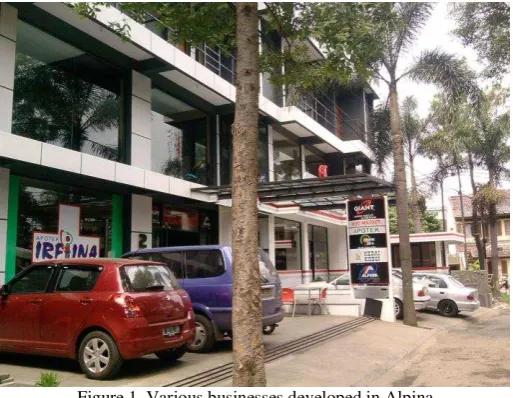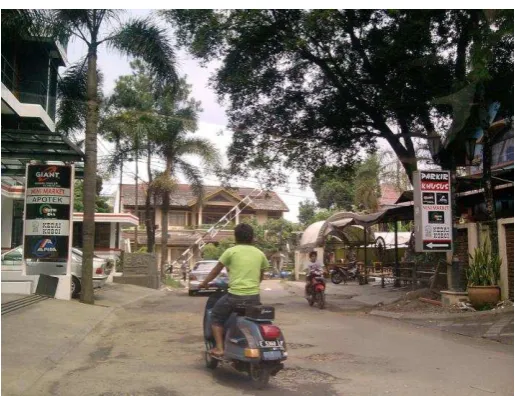Reducing Crime by Creating a Community
Collaborative Space: Case Study on Alpina, Cisitu,
Bandung
Yunita SETYONINGRUM Lecturer - Interior Design Study Programme
Faculty of Art and Design, Maranatha Christian University INDONESIA
ABSTRACT
Cisitu area which is located in northern Bandung was a rural community that has been developed fast within decades to public housing. Now it has developed to a dense housing area, with many beautifully furnished rented spaces dedicated for students who came from outside Bandung. As we might know, Bandung is well-known for its decent academic atmosphere, because there were several good reputation universities and colleges. Located close to ITB, Unpar, and Unpad, Cisitu is one of best area for students from outside the town to live in. The development somehow impacted on social problems in the community that increases crime in this area. This paper focused on how Alpina does its business to fulfill students’ needs around Cisitu area, from a business to a community collaborative space to serve student community. As a positive impact of Alpina collaborative spaces, the community lives in such a social controls that reduce crime in the environment. A collaborative space made by a community with or without leaders has some advantages on reducing criminality in the neighborhood. It stabilized the environment because of the social control created between the people within.
Keywords: crime prevention, boarding students, social bond, defensible space, surveillance
INTRODUCTION
Bandung: Best Choice in Higher Education
Becoming a ‘student city’, Bandung takes in thousands of boarding students every year that come and go. Since the schools cannot provide internal housing facilities or dormitories for their students that come from out of town, they choose to live in the nearest housing areas around their schools for the efficiency and cost reasons. There are many choices of housing facilities, such as rented house, boarding rooms, pavilions that varied in the cost according to location, accessibility and the facilities they provide.
Cisitu is one of the suburban areas that students choose to live in Bandung, especially for students whose schools located in the north. Cisitu that used to be a rural suburban area (kampung), now has developed to a dense area with many housing facilities for students from out of town. Even there are some residential complexes, such as Dago Asri, Kampung Dago, that formerly intended to middle-class family housing, turned to rented space for students. People bought the land, built houses with rooms specifically for rent to students. There are various types of rented houses, from low-cost rooms that provide standard living facility, to high cost rooms with advance facilities and luxury, such as private bathrooms, individual parking area, and wi-fi connections.
SOCIAL PROBLEMS ARISE
Antisocial and Detachment from the Community
When the outsiders came to a neighborhood, such changes happened in the community. From common neighborhood with common local families live in it, transformed to ‘boarding student district’, Cisitu has several problems arise. On one side, some of local people have financial advantages by providing the basic needs of the students, such as accommodation, consumption of goods and food, laundry services, and so on. But in the other side, some of local people are disturbed, felt apart from the community, because the students, which majority are the adolescent from various parts of the country, have freedom attitude and different manners to the local Sundanese. And hence they often ignore the neighborhood outside their homes in order to protect themselves and emphasize their territory. They create their own defensible space that can protect them from outsiders, but the ignorance attitude and their defensible space approach leads to create an antisocial community, which have to be deeply concerned. An antisocial community could endorse to the rise of crime acts that rises from the absence of social control.
Boarding Students as Mature Adolescence: Social Pressure vs Freedom Enthusiasm
new social environment, are overlapping with freedom enthusiasm. This vulnerable condition is prone to adolescence delinquency and crime acts.
Sociologists have researched adolescence delinquency and crime acts, and afterwards social control theories had been developed as solutions of reducing crime acts in adolescence. Ivan Nye (1958) proposed that there are four types of control in order to prevent adolescence delin quency and crime act:
Direct, by which punishment is threatened or applied for wrongful behavior, and compliance is rewarded by parents, family, and authority figures.
Internal, by which a youth refrains from delinquency through the conscience or superego.
Indirect, by identification with those who influence behavior, say because his or her delinquent act might cause pain and disappointment to parents and others with whom he or she has close relationships.
Control through needs satisfaction, i.e. if all an individual's needs are met, there is no point in criminal activity.
(http://en.wikipedia.org )
Start from the statement above, it can be assumed that:
Being far from their families, boarding students have less social control from their environment. Therefore a direct and indirect type of control is rarely effective in here.
Needs satisfaction is hardly accomplished because of the social pressure on them as mature adolescence. It influences internal aspect of them, urge the conscience or superego to commit delinquency or crime.
This paper proposed an example on how built collaborative community could strengthen social bonds in Cisitu ‘boarding student district’. A collaborative community space could improve the level of social interaction and afterwards the social control in the neighborhood in order to reduce the probability of adolescence delinquency (Shoemaker, 1996).
ALPINA AS COMMUNITY COLLABORATIVE SPACE
Creating Natural Defensible Space: Space with Surveillance Which Functions as Social Control
involve in it. As a collaborative space, this small community creates social control following the construction of social interaction among them. The social control in this case is one example of natural surveillance created in collaborative space.
In the Cisitu area, Alpina was established as a small home business. Alpina was originally developed as a commercial business that provided outdoor apparels and equipments. Active and sporty youth, mostly students, are its customer in majority. While sharing similarity of interests, the owner has gathered a community in the business that becomes bigger and solid in years. Over time, it has been developing other businesses, providing the need to gather around. Alpina’s business growth is also supported by the environment around Cisitu, which has been developing into a ‘boarding student district’. Alpina business penetrated more generally, not only aim to community of young people who have similar interests in outdoor activities. It established food stalls and cafes that are open from morning till night, also a mini market that provides primary needs of students living around it. Local residents are also involved in this business as employees and tenants.
Figure 1. Various businesses developed in Alpina Source: writer’s documentation, 2010
Shortly thereafter, Alpina turned into 'meeting point' where it occurs in a fairly intense social interaction. Alpina’s business success is being followed by local residents near them. Other food stalls, laundry business, printing and photocopy service, even motorcycle taxi services have been sprung up around them, which emphasizes Alpina as ‘meeting point’.
Space with surveillance, a place where any individual within it would always kept under surveillance by the surrounding community.
Perceived territory, areas that have significant borders of public and private areas.
Safe zone, where space is divided by its security characteristics.
Newman also proposed that by creating an effective defensible space, the environment safety could rely on the community self-help. Defensible space, in this case natural defensible space with surveillance, depends on resident involvement to reduce crime and the presence of criminals. It also has the ability to bring people of different incomes and backgrounds together in a mutually beneficial union. In fact, for low-income people, defensible space can provide an introduction to the benefits of main-stream life and an opportunity to see how their own actions can better the world around them and lead to upward mobility (http://en.wikipedia.org)
Before Newman, Jane Jacobs in her feminist approach on ‘Eyes on the Street Theory’ said that the environment safety could be improved by ‘putting eyes on the street’ by showing the examples of street facing commercial and public spaces. Both theories concluded on how a community public space that gathered people with different background could be an effective defensible space, because it provided social bonds within groups’ interaction and moreover it provided surveillance and control on the community behavior.
Built face to face in strategic T-intersection of Cisitu Lama Road, Alpina creates an open space to hang out with view to the street. While the interactions begin with business transactions within it, people could oversee clearly to the streets and the surroundings. This is where the surveillance occurs.
Social Bond Construction in Community Collaborative Space
Travis Hirschi (1969) argued that people follow the norms in their community because they have a bond to society. The bond consists of four positively correlated factors: commitment, attachment, belief, and involvement. He also proposed that delinquent peers would have no direct effect on delinquency when social bonds inhibiting delinquency were taken into account. He argued that similarly unattached youth drifted together into delinquent groups because weak social bonds failed to prevent both association with delinquents and delinquency itself. The groups that could strengthen the bonds were family, school, peers, religious institutions, etc. He stressed the rationality in the decision whether to engage in crime and argued that a person was less likely to choose crime if they had strong social bonds. According to Hirschi theories above, it is obvious that in order to control crime acts, the community must provide social bonds that restrain those students from acting crime (http://en.wikipedia.org).
Alpina with its busy social interaction creates space with social bonds between the owner, tenants which are the local residents, and boarding students as Alpina’s customers. Commitment to keep the community safe is constructed within the people who interact in it. The attachment to place is also constructed following the needs to fulfill their daily needs. Belief, in Alpina case, is not a factor considered to correlate in Alpina case, because there are diverse groups of community in it. Involvement of owners, tenants, and customers is constructed within the business transaction in the collaborative space.
CONCLUSION
A lesson that we all can learn from the Alpina as such an example of community collaborative space in Cisitu is that community collaborative spaces could become a natural defensible space in the neighborhood. Particularly in diverse community neighborhood, it can be considered to create informal community collaborative space that includes every layer of society.
The effective method of defending the space dealing with crime is by community surveillance among each other. To create the defensible space with surveillance in collaborative spaces, one should consider:
The collaborative spaces should be easy to reach or be in the strategic area in the neighborhood, yet it should be accessible for everyone. The collaborative spaces should have direct view to the street where people could watch other people and vice versa.
The collaborative spaces should give possibilities to gathered diverse groups of society in natural social interactions, for example is basic trading.
The activities within collaborative spaces should give benefit to all groups in the community, so it will endorse positive social interactions.
NEWMAN, Oscar. (1996). Creating Defensible Space. Washington D.C: U.S Department of Housing and Urban Development.
JACOBS, Jane (1961). The Death and Life of Great American Cities. New York: Vintage.

